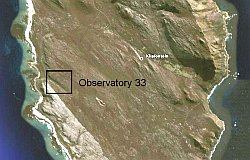Regional overview
 The observatory #33 (Cape Peninsula NP / Cape of Good Hope) is situated on the Cape Peninsula in the Table Mountain National Park (TMNP) south of Cape Town. The Peninsula with an area of 470 km2 is home to 2285 plant species with 90 species endemic to the Peninsula. It is globally regarded as an important hot spot of biodiversity (Cowling et al. 1996, Myers 2000). The typical vegetation is Fynbos, a fine leaved, sclerophyllous and fire-prone shrubland or 'heathland' vegetation associated with low nutrient substrates and summer drought. The observatory #33 (Cape Peninsula NP / Cape of Good Hope) is situated on the Cape Peninsula in the Table Mountain National Park (TMNP) south of Cape Town. The Peninsula with an area of 470 km2 is home to 2285 plant species with 90 species endemic to the Peninsula. It is globally regarded as an important hot spot of biodiversity (Cowling et al. 1996, Myers 2000). The typical vegetation is Fynbos, a fine leaved, sclerophyllous and fire-prone shrubland or 'heathland' vegetation associated with low nutrient substrates and summer drought.
The area is characterized by high topographical heterogeneity resulting in strong differences in mean annual precipitation. In combination with a great variety in lithology, this results in long steep environmental gradients comprising a high number of (micro-) habitats.
The Peninsula experiences a mediterranean climate, characterized by cool, moist winters and warm, dry summers. Mean annual rainfall on the Peninsula ranges strongly from 2270 mm on the table Mountain to only 402 mm at the Cape Point (Cowling et al 1996).
Prominent feature of the landscape is the scenic arrangement of Atlantic Ocean mountainous areas with massifs and plateaus comprised by sandstones and underlied partly by the Cape Granite Suite. Geologically, this region belongs to the Table Mountain Group with the Peninsula formation characterised by quartzite sandstone. A phenomenon of the Fynbos ecosystem is how it manages to support an abundant and diverse vegetation on generally nutrient-poor bedrock, especially the quartz arenite of the Peninsula Formation sandstone (Cowling et al. 1996).
The vegetation of the southern part of the Peninsula, the Peninsula Sandstone Fynbos, is part of the Southwest Fynbos Bioregion (Mucina & Rutherford 2005), accompanied by smaller areas of Sand Fynbos and Strandveld vegetation. Characteristic species are of the Ericaceae, Proteaceae, Asteraceae and Restionaceae families and build high levels of diversity and endemism.
Periodic fires are of major importance for the dynamic of the natural vegetation within the TMNP as a trigger for the renewal and succession of the vegetation. This impact is well visible on the observatory, which is situated in the southern part of the TMNP. Here, the open, whitish aspect in the south west of the observatory goes on account of such a fire in 2002. Grazing impact by game occurs but does not have a considerable impact. A major threat for the unique flora of the northern part of the Peninsula is the pressure by agriculture and urbanization combined with the spreading of invasive alien plants (Richardson 1996). The latter is also a threat for already protected areas like the Cape of Good Hope where the BIOTA observatory is situated.
Observatory description
The observatory itself is situated approx. 10 km north of Cape Point at the west coast in the protected area of the TMNP. The locality is known as Olifantsbos. The landscape comprises a a low sandstone plateau dissected by a few drainage valleys draining towards the coast. Within the observatory mean height is about 100 m asl with the highest area (113 m asl) in the north east. The area is general flat except for the northwestern part, which is characterised by a small valley with a periodical creek and lowest positions about 63 m asl. Mean annual rainfall is about 400 mm (recorded at Cape Point).
Soils of the coarse sandstone are regularly well drained. However, in combination with underlying bedrock and subterranean ridges, drainage on some areas is impeded resulting in waterlogged conditions in the wet winter months. This is reflected in a basic distinction of the vegetation into a proteoid Fynbos on the well drained sites and a restioid Fynbos on the seasonally waterlogged sites. Water logged conditions predominantly occur in the north-east and the south-east of the observatory clearly visible by a browner colour of the vegetation aspect and less arenite outcrops. Although these parts are the highest within the observatory water logging occurs by the presence of sandstone barriers in the ground that function like a barrier and cause shallow waterlogged or even flooded basins. A small seasonal creek drains the area of the observatory towards the valley in the northwest. During fieldwork waterlogged conditions on the observatory and drainage by the creek was evident.
An additionally important feature of the observatory is the heterogeneous structure of the underlying sandstone resulting in a small-scale pattern of outcrops, especially in its western part. As a typical dynamic feature of the Fynbos, the most south-western part of the observatory experienced a bush fire in 2002, which destroyed the vegetation. In Figure 1, the two current aspects along the fire-borderline are shown. On the left side the proteoid Fynbos still exists while on the right side a three-year old succession stage has been established on the burned site.
For the ranking procedure, only two habitats were distinguished: burned and unburned habitat.

Figure 1:Typical aspect of proteoid Fynbos (left) and recent burned area (right) |
